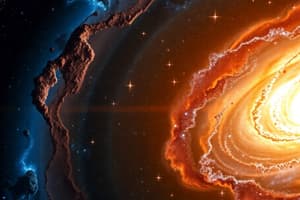Podcast
Questions and Answers
What is the estimated age of the galaxy JWST-ER1g?
What is the estimated age of the galaxy JWST-ER1g?
- 1.9 ± 0.3 Gyr (correct)
- 2.5 ± 0.4 Gyr
- 3.1 ± 0.5 Gyr
- 1.2 ± 0.3 Gyr
What is the approximate stellar mass of JWST-ER1g?
What is the approximate stellar mass of JWST-ER1g?
- 1.7 × 10^11 M⊙
- 1.5 × 10^11 M⊙
- 1.0 × 10^11 M⊙
- 1.3 × 10^11 M⊙ (correct)
What is the effective radius of JWST-ER1g?
What is the effective radius of JWST-ER1g?
- 1.7 ± 0.2 kpc
- 2.1 ± 0.2 kpc
- 1.9 ± 0.2 kpc (correct)
- 1.5 ± 0.2 kpc
What is the dark matter mass within the Einstein radius?
What is the dark matter mass within the Einstein radius?
What is the star formation rate of JWST-ER1g?
What is the star formation rate of JWST-ER1g?
Why is JWST-ER1g not a quiescent galaxy?
Why is JWST-ER1g not a quiescent galaxy?
What is the shape of JWST-ER1g?
What is the shape of JWST-ER1g?
What is the significance of the Einstein ring in strong lensing?
What is the significance of the Einstein ring in strong lensing?
What is the implication of the galaxy's compactness?
What is the implication of the galaxy's compactness?
What is the role of the Navarro-Frenk-White (NFW) profile?
What is the role of the Navarro-Frenk-White (NFW) profile?
Flashcards are hidden until you start studying
Study Notes
JWST-ER1g Properties
- JWST-ER1g has a total mass of Mlens = 6.5-1.5 × 10^11 M⊙ within r = 6.6 kpc.
- Stellar mass within the Einstein radius is Mstars = (1.1-0.3 × 10^11) M⊙ for a Chabrier IMF.
- Lens mass is a factor of 5.9+4.1-1.6 higher than the stellar mass.
Possible Contributors to Lensing Mass
- Unlikely that significant fraction of lensing mass is in the form of gas.
- Observations of lensed quiescent galaxies and simulations find low gas masses.
- No hidden obscured starburst in JWST-ER1g, with an upper limit to the star formation rate of 63 M⊙ yr^-1.
Dark Matter Profile
- Dark matter density within the Einstein radius is a factor of ~2 higher than expected from scaling relations.
- Two possible options for the 'extra' dark matter:
- Total halo mass could be higher than expected from the canonical stellar mass-halo mass relation.
- Baryonic processes could lead to a dark matter profile that deviates from the NFW form.
Dark Matter within the Einstein Radius
- Dark matter mass within the Einstein radius is Mdm = 2.6+1.6-0.7 × 10^11 M⊙ for a NFW halo.
- Assumes a Navarro-Frenk-White (NFW) profile and the stellar mass-halo mass relation for z = 2.
Galaxy Properties
- JWST-ER1g is a quiescent galaxy, with an age of 1.9+0.3-0.6 Gyr and a low star formation rate of 4+19 M⊙ yr^-1.
- Galaxy is compact, with an observed effective radius of re = 1.9 ± 0.2 kpc.
- No obvious star-forming regions, tidal tails, or other irregularities in the residuals from the GALFIT fit.
Studying That Suits You
Use AI to generate personalized quizzes and flashcards to suit your learning preferences.





